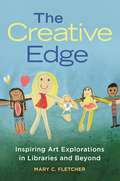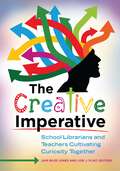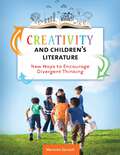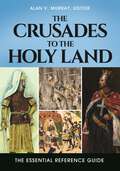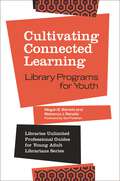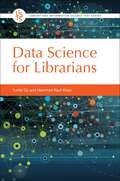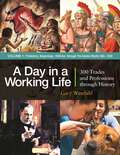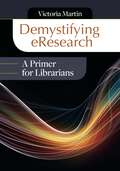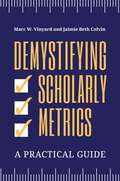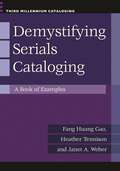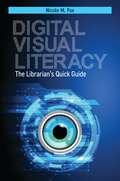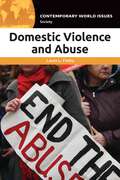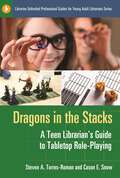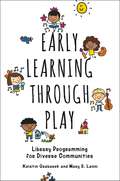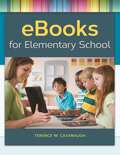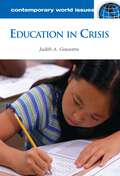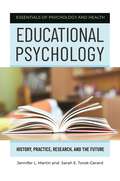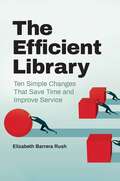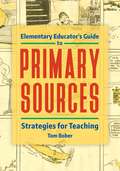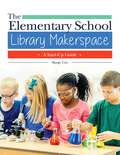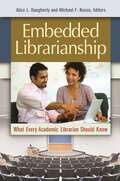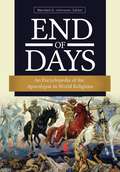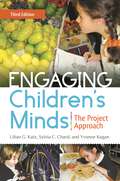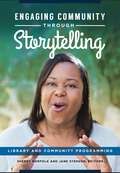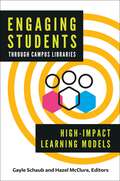- Table View
- List View
The Creative Edge: Inspiring Art Explorations in Libraries and Beyond
by Mary C. FletcherLibrary facilitators of art-based creativity sessions will learn how to choose materials and art experiences appropriate for young people from toddlers to teens and for intergenerational groups.In the modern world, innovative and creative individuals have a distinct advantage: the creative edge. The Creative Edge explains how you can design and conduct art-based creativity programming in your library. Written by a library creativity specialist, this book is the result of the author's many years of experience facilitating art groups for all ages. Her programs have achieved national recognition and will serve as a guide for others to establish art-based creativity sessions. In this book, she incorporates research that documents the importance of creativity as an essential component of childhood development and connects it to library learning goals, including literacy.Creativity research can be applied in libraries and at other public institutions to develop programs that will meet the needs of the next generation. The book includes many practical elements, such as lists for recommended art materials, step-by-step instructions on setup and procedures, and ideas inspired by picture book illustrations that connect to story time themes. The Creative Edge teaches readers how to provide programs that promote child-led exploration, experiential learning, innovative thought, and creative confidence.
The Creative Imperative: School Librarians and Teachers Cultivating Curiosity Together
by Jami Biles Jones and Lori J. FlintProvides a solid, foundational understanding of creativity that enables readers to elicit creative performance from their students.The first book of its kind in the school library field, The Creative Imperative: School Librarians and Teachers Cultivating Curiosity Together assists educators, school librarians, school counselors, and parents in learning about creativity and inquiry as well as how to foster these desired processes in school settings and beyond. The work begins by addressing the foundational aspects of creativity, and then discusses creativity within the educational setting, exploring how educators can be more creative themselves and coax creative performance from their students. The final part of the text focuses specifically on school libraries and the role of librarians in developing environments and opportunities for inquiry that nurture creativity.
Creativity and Children's Literature: New Ways to Encourage Divergent Thinking
by Marianne SaccardiToday's students need to be able to do more than score well on tests—they must be creative thinkers and problem solvers. The tools in this book will help teachers and parents start students on the path to becoming innovative, successful individuals in the 21st century workforce.The children in classrooms today will soon become adult members of society: they will need to apply divergent thinking skills to be effective in all aspects of their lives, regardless of their specific occupation. How well your students meet complicated challenges and take advantage of the opportunities before them decades down the road will depend largely upon the kind of thinking they are trained and encouraged to do today. This book provides a game plan for busy librarians and teachers to develop their students' abilities to arrive at new ideas by utilizing children's books at hand.Following an introduction in which the author defines divergent thinking, discusses its characteristics, and establishes its vital importance, chapters dedicated to types of literature for children such as fantasy, poetry, and non-fiction present specific titles and relevant activities geared to fostering divergent thinking in young minds. Parents will find the recommendations of the kinds of books to read with their children and explanations of how to engage their children in conversations that will help their creative thinking skills extremely beneficial. The book also includes a case study of a fourth-grade class that applied the principles of divergent thinking to imagine innovative designs and come up with new ideas while studying a social studies/science unit on ecology.
The Crusades to the Holy Land: The Essential Reference Guide
by Alan V. Murray, EditorBased on the latest scholarship by experts in the field, this work provides an accessible guide to the Crusades fought for the liberation and defense of the Holy Land—one of the most enduring and consequential conflicts of the medieval world.The Crusades to the Holy Land were one of the most important religious and social movements to emerge over the course of the Middle Ages. The warfare of the Crusades affected nearly all of Western Europe and involved members of social groups from kings and knights down to serfs and paupers. The memory of this epic long-ago conflict affects relations between the Western and Islamic worlds in the present day. The Crusades to the Holy Land: The Essential Reference Guide provides almost 90 A–Z entries that detail the history of the Crusades launched from Western Europe for the liberation or defense of the Holy Land, covering the inception of the movement by Pope Urban II in 1095 up to the early 14th century. This concise single-volume work provides accessible articles and perspective essays on the main Crusade expeditions as well as the important crusaders, countries, places, and institutions involved. Each entry is accompanied by references for further reading. Readers will follow the career of Saladin from humble beginnings to becoming ruler of Syria and Egypt and reconquering almost all of the Holy Land from its Christian rulers; learn about the main sites and characteristics of the castles that were crucial to the Christian domination of the Holy Land; and understand the key aspects of crusading, from motivation and recruitment to practicalities of finance and transport. The reference guide also includes survey articles that provide readers with an overview of the original source materials written in Latin, Arabic, Greek, Hebrew, Armenian, and Syriac.
Cultivating Connected Learning: Library Programs for Youth (Libraries Unlimited Professional Guides for Young Adult Librarians Series)
by Megan E. Barrett Rebecca J. RanalloIf you want to boost your library's relevancy and support youth learning, consider incorporating connected learning at your library. This book helps you to realize the potential of this exciting and dynamic trend.Learning doesn't just happen in the classroom: it happens everywhere. The connected learning model supports this principle, asserting that young people learn best when their experiences are interest-driven, peer-supported, and rooted in solid academics. Libraries are the perfect environment for this type of learning, providing a place where teens can connect with each other and with adult mentors to engage with learning material and thrive. This book shows you how to cultivate connected learning in your library. You'll discover what the approach involves, its benefits, and what it can look like in various library settings. You'll also learn how to generate support for connecting learning within your library; reimagine your spaces and programs to better support connected learning; integrate technology into programs and services to make it accessible to youth; build partnerships with other libraries as well as other organizations; recruit volunteers; and raise community awareness to increase involvement.
Data Science for Librarians (Library and Information Science Text Series)
by Yunfei Du Hammad Rauf KhanThis unique textbook intersects traditional library science with data science principles that readers will find useful in implementing or improving data services within their libraries.Data Science for Librarians introduces data science to students and practitioners in library services. Writing for academic, public, and school library managers; library science students; and library and information science educators, authors Yunfei Du and Hammad Rauf Khan provide a thorough overview of conceptual and practical tools for data librarian practice. Partially due to how quickly data science evolves, libraries have yet to recognize core competencies and skills required to perform the job duties of a data librarian. As society transitions from the information age into the era of big data, librarians and information professionals require new knowledge and skills to stay current and take on new job roles, such as data librarianship. Such skills as data curation, research data management, statistical analysis, business analytics, visualization, smart city data, and learning analytics are relevant in library services today and will become increasingly so in the near future. This text serves as a tool for library and information science students and educators working on data science curriculum design.
A Day in a Working Life [3 volumes]: 300 Trades and Professions through History [3 volumes]
by Gary WestfahlIdeal for high school and college students studying history through the everyday lives of men and women, this book offers intriguing information about the jobs that people have held, from ancient times to the 21st century.This unique book provides detailed studies of more than 300 occupations as they were practiced in 21 historical time periods, ranging from prehistory to the present day. Each profession is examined in a compelling essay that is specifically written to inform readers about career choices in different times and cultures, and is accompanied by a bibliography of additional sources of information, sidebars that relate historical issues to present-day concerns, as well as related historical documents.Readers of this work will learn what each profession entailed or entails on a daily basis, how one gained entry to the vocation, training methods, and typical compensation levels for the job. The book provides sufficient specific detail to convey a comprehensive understanding of the experiences, benefits, and downsides of a given profession. Selected accompanying documents further bring history to life by offering honest testimonies from people who actually worked in these occupations or interacted with those in that field.
Demystifying eResearch: A Primer for Librarians
by Victoria MartineResearch presents new challenges in managing data. This book explains to librarians and other information specialists what eResearch is, how it impacts library services and collections, and how to contribute to eResearch activities at their parent institutions.Today's librarians need to be technology-savvy information experts who understand how to manage datasets. Demystifying eResearch: A Primer for Librarians prepares librarians for careers that involve eResearch, clearly defining what it is and how it impacts library services and collections, explaining key terms and concepts, and explaining the importance of the field. You will come to understand exactly how the use of networked computing technologies enhances and supports collaboration and innovative methods particularly in scientific research, learn about eResearch library initiatives and best practices, and recognize the professional development opportunities that eResearch offers.This book takes the broad approach to the complex topic of eResearch and how it pertains to the library community, providing an introduction that will be accessible to readers without a background in electronic research. The author presents a conceptual overview of eResearch with real-world examples of electronic research activities to quickly increase your familiarity with eResearch and awareness of the current state of eResearch librarianship.
Demystifying Scholarly Metrics: A Practical Guide
by Marc W. Vinyard Jaimie Beth ColvinDemystifying Scholarly Metrics gives librarians and faculty the confidence to navigate the maze of scholarly metrics, identify quality journals in which to publish, and measure the impact of scholarly works.Both librarians and professors can be overwhelmed by the bewildering number of scholarly metrics. This user-friendly book demystifies them, helping librarians become familiar with scholarly metrics and giving them the confidence to assist faculty at their institutions. It also equips faculty authors with the knowledge to evaluate journals and use metrics to track their scholarly impact.Several controversies exist in the scholarly metrics landscape, including a disagreement between the proponents of altmetrics and traditional bibliometrics. Even more contentious debates are breaking out over predatory journals and open access publishing. Authors Mark Vinyard and Jaimie Beth Colvin, who successfully launched a faculty publishing initiative, explain which aspects of metrics are truly essential to grasp, and they place these numbers in context. They help readers identify the metrics that are the best fit for their scholarship and give librarians and professors the tools to make smart decisions in this changing scholarly metrics landscape.
Demystifying Serials Cataloging: A Book of Examples (Third Millennium Cataloging)
by Fang Huang Gao Heather Tennison Janet A. WeberThis essential reference teaches library staff how to handle the most common and confusing problems in serials cataloging by providing clear examples, practice exercises, and helpful advice based on experience.Serials cataloging can be an overwhelming task that frustrates even the most seasoned professional. This book provides simple guidance and real-world examples to illustrate best practices in serials cataloging.Demystifying Serials Cataloging: A Book of Examples is a reliable reference for learning how to catalog serials or improve cataloging skills. The book covers important elements of descriptive cataloging of serial publications such as explanations, sample records, applicable cataloging rules, and images of the serials. Examples demonstrate best practices and guidelines from the industry's leading cataloging standards including Anglo-American Cataloguing Rules: Second Revised Edition; CONSER Cataloging Manual; Library of Congress Rule Interpretation; and OCLC Bibliographic Formats and Standards. Each chapter contains helpful practice exercises to ensure understanding and reinforce learning.
Digital Visual Literacy: The Librarian's Quick Guide
by Nicole M. FoxDesigned to introduce visual literacy to instructional librarians, this book shows librarians how to make visual literacy relevant and engaging by framing it as a digital skill.Millions of images are uploaded to social media every day, and students are increasingly being asked to participate in such image-rich research projects as websites and blogs. Image manipulation and photo editing are commonplace, but the visual literacy skills needed to detect that kind of misinformation aren't.Students need help learning how to find, evaluate, and use images in an ethical and effective manner. Digital Visual Literacy is designed to introduce visual literacy to instructional librarians. This concise introduction teaches visual literacy as a digital skill, complete with digital humanities-based workshops and assignments to make instruction informative and engaging. It covers all aspects of visual literacy, from copyright to image evaluation. Each chapter clearly explains visual literacy standards and proficiencies and offers practical instructional assignments, in-class demonstrations, and more through the use of digital humanities tools.
Domestic Violence and Abuse: A Reference Handbook (Contemporary World Issues)
by Laura L. FinleyA comprehensive and timely resource for students, activists, educators, and advocates, Domestic Violence and Abuse: A Reference Handbook provides a rich and scholarly assessment of this important social issue while also including stories and profiles for a more personal understanding.Domestic Violence and Abuse: A Reference Handbook provides a thorough review of the most recent research about intimate partner violence. Additionally, a historical review provides readers with a sense of how views on domestic violence have changed over time and how different policies and practices have and have not been successful. Appropriate for readers at the high school level and above, the volume focuses on the scope, extent, and characteristics of domestic violence and offers several unique elements, including profiles of significant individuals, personal stories from advocates, activists and survivors, and a review of controversial issues. The volume also includes a chronology of key events, relevant data and documents, primary source data, and recommended resources.
Dragons in the Stacks: A Teen Librarian's Guide to Tabletop Role-Playing (Libraries Unlimited Professional Guides for Young Adult Librarians Series)
by Steven A. Torres-Roman Cason E. SnowA one-stop, complete guide to tabletop role-playing games for novice librarians as well as seasoned players.Tabletop role-playing games (RPGs) are a perfect fit for library teen services. They not only hold great appeal for teen patrons, but also help build important skills ranging from math and literacy to leadership and dramatics. Role-playing games are cost-effective too. Dragons in the Stacks explains why RPGs are so effective at holding teenagers' attention, identifies their specific benefits, outlines how to select and maintain a RPG collection, and demonstrates how they can enhance teen services and be used in teen programs. Detailed reviews of role-playing games are included as well, with pointers on their strengths, weaknesses, and library applications. Coauthored by an experienced young adult librarian and an adult services librarian, this is the definitive guide to RPGs in the library, and the only one currently available.
Early Learning through Play: Library Programming for Diverse Communities
by Kristin Grabarek Mary R. LanniThis creative guidebook teaches librarians in diverse communities how to develop and implement early learning programming beyond traditional storytimes.While traditional library storytimes are excellent tools for families, equally important is play. Children learn through play in many ways; it stimulates exploration and curiosity and builds gross and fine motor skills that are critical to reading and writing success. Perhaps most importantly, play has the power to cross barriers of culture and language, allowing families from differing backgrounds to learn together.In this book, Kristin Grabarek and Mary R. Lanni—the pioneers of Little University, an early learning program that focuses on play-based learning—share their experiences and provide guidance for implementing similar programs at libraries of various sizes and budgets. They teach readers how to create programs for a diverse group of families, work with outside providers, choose supplies, estimate costs, market your programming, and overcome the challenges of both big and small budgets and many or few patrons. These practical plans will enhance storytimes and even help build a brand-new early learning program.
eBooks for Elementary School
by Terence W. CavanaugheBooks offer students as well as teachers, school and public librarians, and parents tremendous possibilities. This book explains how to expand and enhance the reading experience through the use of technology.Today, eBooks are everywhere, and the use of digital learning materials is beginning to supplant traditional printed materials. As the world shifts to digital books, both teachers and students need to be comfortable and effective using materials in this format. This book helps you to apply eBook materials to existing curricula to create interactive educational activities and have access to more materials to support reading instruction, literacy, standards, and reading in the content areas. Author Terence W. Cavanaugh, an expert on teaching with technology, describes numerous strategies for integrating eBooks into reading instruction and remediation for students in preschool through grade 6. He covers the hardware and software used, the wide range of formats available, and research conducted on the use of eBooks with students as well as how to access free resources such as digital libraries and special collections that make eBooks available for schools. The book also contains a chapter dedicated to using eBooks to help emergent or struggling readers.
Education in Crisis: A Reference Handbook (Contemporary World Issues)
by Judith A. GouwensA description and critique of education reform in the United States since the 1950s, focusing on the current condition of American schools and efforts to increase both educational opportunity and overall excellence.Authoritative and objective, Education in Crisis: A Reference Handbook is a critical look at the current state of the American school system, the conditions that have led many to label it "in crisis," and solutions aimed at leveling the educational playing field, elevating overall student achievement, and keeping American students competitive on the world stage.Education in Crisis shows how competing economic, political, philosophical, psychological, and global interests have influenced American education reform. It then covers a range of reform initiatives, including magnet schools, basic skills curriculum, home schooling, and the role of technology. A comparison of the U.S. education system to those of other countries and a presentation of helpful resources round out this essential volume for educators, policymakers, parents, and anyone concerned about the nation's schools.
Educational Psychology: History, Practice, Research, and the Future (Essentials of Psychology and Health)
by Jennifer L. Martin Sarah E. Torok-GerardA comprehensive introduction to educational psychology, this volume is inclusive of all of the essentials—covering history, profiles, theories, applications, research, case studies, current events, issues, controversies, and more.Focused on human learning and teaching, the field of educational psychology informs a range of educational challenges, including instructional design, curriculum development, organizational learning, special education, student motivation, and classroom management. In this book, two veteran professors in the fields of education and psychology, offer a clear and concise yet comprehensive overview of this growing specialty. This volume will be valuable not only to university students aiming to understand psychology's subfields and to choose a major or a specialty, but also to classroom teachers, school administrators, and school social workers aiming to make teaching more effective and learning more thorough and lasting. Topics include the field's history, primary figures theories, research, theories, applications, issues, and controversies. Authors Martin and Torok-Gerard also explain current issues of social justice and educational equity, citing means that have been used to meet those goals in schools. The text additionally analyzes special education as a civil rights issue as well as equity and fairness for LGBTQ+ students in the context of social justice. The text ends with emerging research and predictions for the future of educational psychology.
The Efficient Library: Ten Simple Changes That Save Time and Improve Service
by Elizabeth Barrera RushThis guide helps librarians improve service with easy-to-follow strategies and techniques to make physical changes in library space and streamline procedures.This librarian's guide provides recommendations for quick and easy implementation of space-improving, time-saving practices. It also discusses the fundamentals of business and engineering management, public health, and other disciplines as they directly relate to the improvement of library service and management. Detailing free and affordable adjustments to the library environment as well as information for those who will participate in a renovation or new construction project, the book features tips for creating functional, efficient, and productive spaces; procedures for streamlining routine tasks; methods for arranging materials in high demand; and ways of reconfiguring or planning spaces. It will provide librarians with a working knowledge of process management that will help them to strengthen their competence and build confidence to address and troubleshoot problems, freeing them to engage in more meaningful interactions and activities that benefit the community.
Elementary Educator's Guide to Primary Sources: Strategies for Teaching
by Tom BoberFocusing on student analysis of primary sources, this book explores several proven analysis strategies to use with students, including methods from the Library of Congress, the Stanford History Education Group, and Harvard's Project Zero.Many elementary school librarians and teachers want to incorporate primary sources into their lessons but struggle with how to do it. Whether you are starting from the beginning, have used strategies that didn't seem to work, or were underwhelmed by others' suggestions, this book shows you how you can successfully supplement and deepen your students' learning with primary sources.Focusing on proven strategies for elementary students, the book is divided into four sections, each of which demonstrates the strategies through real-world examples of student work. In the first three parts, it explores the three major considerations for using primary sources, strategies for analyzing primary sources, effectively using primary sources to teach different subject areas, and special considerations for different primary source formats. In the final part, the author shares tips that he has learned after years of bringing primary sources into his elementary school that will ensure success in students' primary source analysis.
The Elementary School Library Makerspace: A Start-Up Guide
by Marge CoxA must-read for elementary school librarians interested in starting a makerspace at their school, but who are concerned about the cost and are looking for curriculum links for getting started.Makerspaces are a powerful way to expand a school library's influence as an educational partner in the school community. However, many elementary school librarians and educators are hesitant to consider adding a makerspace to their programming due to concerns about costs. This book focuses on effective ways to start a makerspace in your school on a shoestring budget while simultaneously supporting curriculum standards and inviting the collaboration of other members of your school community. Today's school librarians have many responsibilities and often face a shrinking budget. The Elementary School Library Makerspace: A Start-Up Guide is a one-stop shop for learning the specific steps to successfully starting an elementary school library makerspace, without getting behind on managing your current school library tasks and responsibilities or blowing your budget. You'll learn how and where the makerspace movement started, and why; understand why today's young students crave hands-on experiences; and receive dozens of makerspace examples for each grade level by content area, including ones for language arts, math, science, engineering, arts, social studies, and technology. The book also covers how and why to track particular numbers regarding program performance, explains how to use creativity to start your makerspace with minimal dollars, and outlines how to make your PR efforts in letting others know about your school library makerspace effective in engaging many possible audiences.
Embedded Librarianship: What Every Academic Librarian Should Know
by Alice L. Daugherty and Michael F. RussoIn the ongoing evolution of the academic library, embedded librarianship has become an important topic of debate across levels and departments. This book delves into the concept, examining everything from theory to best practices.Is the embedded librarian an equal partner in the course, or is the librarian perceived as a "value-added" extra? What is the place of technology in this effort? Is there a line librarians should not cross? Taking into account both theory and practice to discuss multiple facets of the subject, Embedded Librarianship: What Every Academic Librarian Should Know thoroughly examines these questions and more from the perspectives of experienced embedded librarian contributors who have worked in higher education settings. The chapters illuminate the benefits and challenges of embedding, explain the planning required to set up an embedded course, identify the different forms of embedding, and consider information literacy instruction in various contexts.Readers who will benefit from this work include not only academic librarians but any professor who wants their students to be able to do better research in their fields.
End of Days: An Encyclopedia of the Apocalypse in World Religions
by Wendell G. JohnsonCovering religious traditions ranging from Buddhism to Christianity to Zoroastrianism and modern apocalyptic movements such as Arun Shinrikyo and the Branch Davidians, this book addresses prophesied end of days from a breadth of perspectives and includes material on often-neglected themes and genres.End of Days: An Encyclopedia of the Apocalypse in World Religions describes apocalyptic writings in the world's major religious traditions, including Judaism, Christianity, Islam, Hinduism, and Buddhism. The cross-referenced entries address ancient traditions—Zoroastrianism, as one example—as well as modern apocalyptic movements, such as Arun Shinrikyo, the Branch Davidians, and the Order of the Solar Temple.This book's broad scope offers coverage of overlooked traditions, such as Mayan Apocalyptic, Norse Apocalyptic, Native American eschatological literatures, and the Tibetan Book of the Dead. Readers seeking detailed information on the eschatological and apocalyptic movements and proponents of End Times can reference entries about individuals such as Harold Camping, Jerry Falwell, David Koresh of the Brand Davidians, and James Jones and the People's Temple. This single-volume encyclopedia also contains numerous historical entries on subjects such as the Great Disappointment, the Great Awakening periods of religious revival, Joachim of Flora, the Maccabean Revolt, and the Plymouth Brethren. The influence of apocalyptic ideas far outside the realm of religion itself is documented through entries on film, including well-known modern movies such as The Hunger Games and Apocalypse Now, literature by writers such as Dante, and works of fine art like Wagner's Götterdämmerung. The inclusion of entries related to literature, film, and other art forms further attests to the wide-ranging social influence of belief in the end of days.
Engaging Children's Minds: The Project Approach
by Lilian G. Katz Sylvia C. Chard Yvonne KoganNow in its third edition, this book shows teachers how to incorporate the Project Approach into early childhood curricula, engaging children intellectually and heightening their capacities for thinking, hypothesizing, reasoning, and expressing their natural curiosity.Why has the Project Approach proven to be so successful for engaging young children intellectually and supporting their capacities to think, predict, hypothesize, reason, and express their natural curiosity? Simply put, because project work provides meaningful contexts in which young learners can readily apply and grasp the usefulness of their growing academic skills. This book provides a brief history and overview of the Project Approach and a thorough explanation of how to implement this method for best effect in a wide range of educational contexts.Intended for those who work with young children as well as caregivers and students in training to do so, readers will understand how to apply this approach in order to gain the interest of children and facilitate their mental growth. The book's chapters articulate the process and benefits of the project approach, identify and detail the three typical phases of project work, and provide specific suggestions for implementing each stage. The importance of documentation of the children's work to record the story of their investigation and findings is also discussed.
Engaging Community through Storytelling: Library and Community Programming
by Sherry Norfolk and Jane StensonThis exploration of model storytelling projects shows librarians how to expand their roles as keepers of the stories while strengthening their communities.Community life is built on its stories. Our history and culture—those of society and of individuals—are passed from generation to generation through stories. Engaging Community through Storytelling: Library and Community Programming examines a wide variety of model storytelling projects across the country, reflecting how storytelling can encourage community attachment, identity, and expression in libraries, community centers, and schools. The contributed essays—written by experts in their fields, many of whom served as developer, fundraiser, director, and implementer of their project—provide detailed information about the inner workings of a wide variety of model storytelling projects from across the country. The authors delineate the need, scope, and audience for each project and offer riveting anecdotes that evaluate the success of that project. Many of the articles are accompanied by one or more photographs documenting the work or practical how-to-do-it guides to encourage and enable replication. Thoughtful commentary on and review of the key concepts in each chapter are provided by the book's editors.
Engaging Students through Campus Libraries: High-Impact Learning Models
This collection of collaborative, high-impact learning experiences in information literacy teaches librarians how to engage students in hands-on, experiential learning.The Association of American Colleges and Universities (AAC&U) has identified 11 practices that are highly impactful to student learning to designate as high-impact educational practices (HIP). These practices engage students deeply in a meaningful, connected way to their work. Librarians teach and support student learning in many ways that assist these AAC&U practices, such as information literacy instruction for capstone, writing, and first-year seminars and research support for collaborative assignments and projects. Engaging Students through Campus Libraries calls attention to work in information literacy that goes beyond a traditional librarian role; it features librarians and faculty partners who engage in projects that highlight salient, experiential facets of the AAC&U practices in order to teach information literacy. In this book, librarians will learn high-impact, experiential learning models for working with students. They will understand how to think about and describe how AAC&U best practices are currently embodied in their organizations. They will also imagine future learning experiences for students with HIPs in mind, resulting in information literacy that is integrated into disciplinary work in a vital and transformative way.
